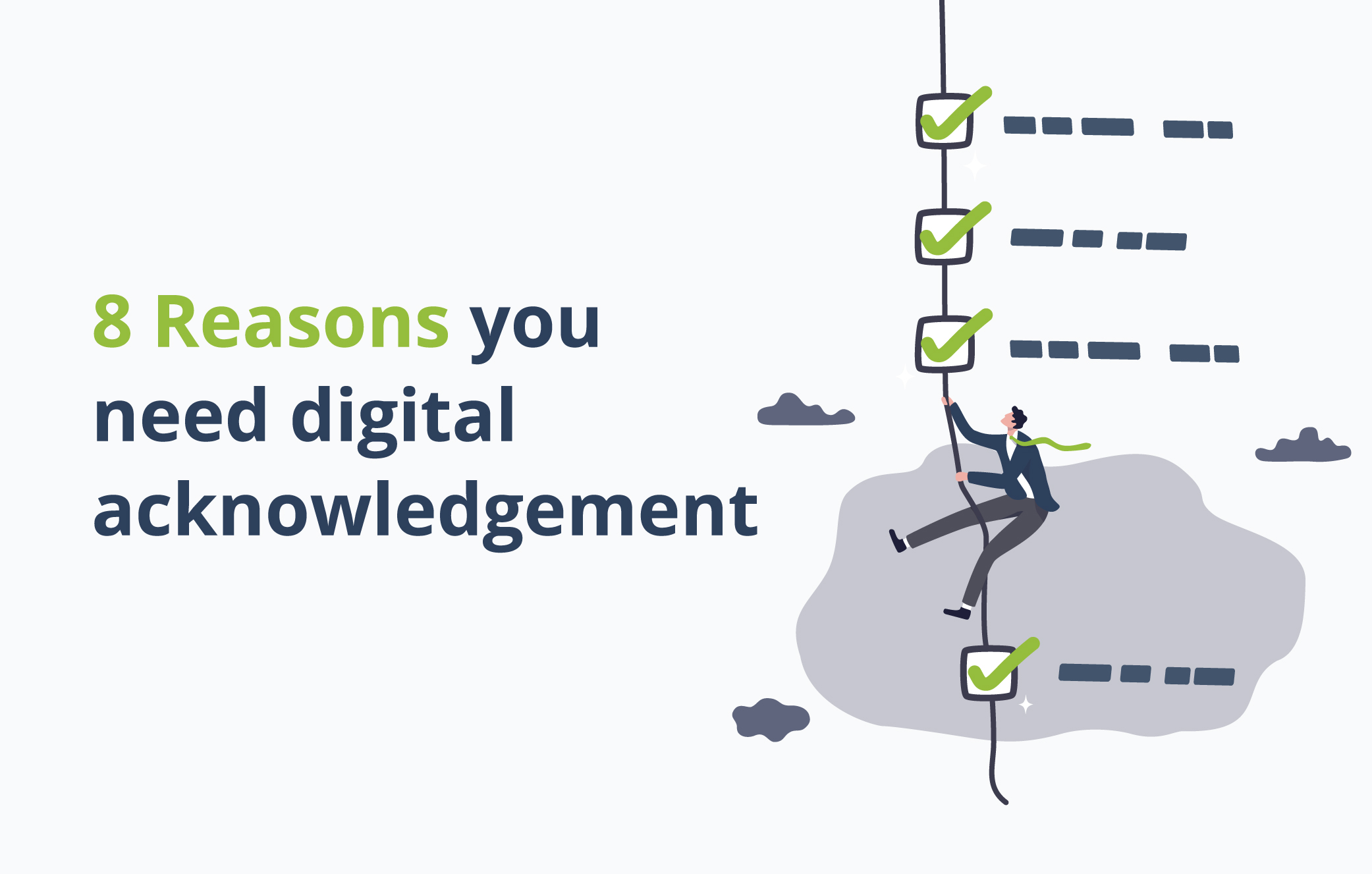
8 reasons why you need digital acknowledgement
In the digital world, getting noticed matters. Digital acknowledgement is an employers secret weapon.
The digital world is full of noise, apps, notifications and loads of other distractions which make it easy to miss or overlook things which come our way.
This can be problematic for employers who are trying to communicate important policies, compliance information or company updates with staff, they may be disregarded and go unnoticed.
Key Points
Four out of five organisations have indicated negative consequences due to a reactive or manual approach to compliance.
According to a Gallup study, consistent communication significantly boosts engagement.
In 2023, 42% of compliance and risk professionals said one of their top policy management challenges was training employees on policies.
Some companies still opt to print and chase people for signatures, but for remote or time-poor companies, this can be hard to maintain long-term.
However, those that use emails to communicate are now facing a different challenge, and that’s how to know if an email has been read.
While emails are an effective communication tool, they fall short for those all-important compliance documents as its difficult to prove someone has actually read and understood what you sent them, not just opened it.
Here’s 8 reasons why you should consider digital acknowledgement software.
What is Digital Acknowledgement Software?
Digital acknowledgement is essentially an email system, but with all the compliance functionality of tracking, signing, collaborating, reporting and more.
Digital acknowledgement software, like Read & Sign, allows you to send information and documents to all the right people and places, in a few clicks.
You can monitor engagement once something is sent, keep tabs on your most important notices and ensure non-responders are automatically notified of any pending documents.
1. Security and Confidentiality

Emails are a common target for various scams, phishing attempts, hacks and other breaches. In 2023 75% of companies experienced an increase in email-based threats (source).
Paper documents are notorious for going missing or being misplaced. They are also often left in plain sight for anyone to peek into or even accidentally dispose of.
In the event of an emergency, such as a fire, documents in storage would also be lost, posing a huge risk to any paper-based business.
Digital acknowledgement systems are designed to prioritise security and confidentiality, making them indispensable for confidential documents.
With secure cloud storage, two factor authentication and lots of other protective measures, these systems safeguard your information.
2. Data Rich Reports

Emails lack real-time tracking and reporting, making it challenging to gather any useful insight into acknowledgements or engagement.
While big email providers like Gmail and Outlook offer read and delivered receipts, these aren’t enough to measure a persons understanding of what you sent them.
Paper based acknowledgements offer very limited data, require manual tracking and lots of time to compile, leading to long delays in gathering any sufficient level of data.
Digital acknowledgement systems give you real time tracking and generate data-rich reports instantly. This gives you immediate insights into a documents status, user understanding through things like quizzes, acknowledgement rates, non-responders and more.
3. Audits and Compliance

Putting together a comprehensive audit trail can be a tough task without a robust system in place.
According to the 2023 Compliance Trends Report, four out of five organisations have indicated negative consequences due to a reactive or manual approach to compliance.
Emails often lack oversight on the entire process, and while its possible to obtain some level of data and receipts, it’s likely to be someone’s full time job to do so, and even then it likely the data wouldn’t be sufficient for audit.
Any data which requires long hours of human data-entry to maintain is prone to error.
Digital acknowledgment systems are robust for maintaining a clear audit trail, without all the leg-work. At a moment’s notice you can pull reports, view information at different levels such as departments, and satisfy any compliance queries.
4. Time-Saving for the Time-Poor

Data-entry is a long, repetitive task. Those in a position responsible for company compliance are likely to be limited on time, so it’s a task that’s often delegated to someone in a more junior role.
Automated data entry has a recorded accuracy rate of 99.959 to 99.99% compared to human data entry rates from 96 to 99%.
Digital acknowledgement allows the correct people to maintain ownership of important compliance data, without risk of data-entry issues. Data is generated directly from user engagement and can’t be edited until exported, so you always have a single point of truth.
5. Consistency Equals Engagement

Consistency is key for most businesses, whether in sales, marketing, operations or communication.
Apart from the evident advantages in business, there are also less apparent benefits for compliance. According to a Gallup study, consistent communication significantly boosts engagement.
Utilising a Digital Acknowledgment System allows you to schedule tasks, uphold a steady acknowledgement process, educate staff on expectations, ensuring everyone knows where to go, what to do, and what their responsibilities are.
6. Maintaining Your Internal Data Flow

One huge issue in todays tech world is that we often have a complicated tech stack of software, data and processes which all need to talk. The 2023 SaaS Management Index report revealed that even the average small business has 172 apps.
Adhoc methods of managing acknowledgements such as paper and email often operate in isolation, lacking integration and causing potential inconsistencies.
Digital acknowledgement systems present data in a way which is much easier to feed into your important processes and maintain an effective workflow. Through integrations and data exports you can easily create an interconnected workflow.
7. Distribution is half the battle

In 2023, 42% of compliance and risk professionals said one of their top policy management challenges was training employees on policies.
Distributing information is half the battle when it comes to sending out important documents that require acknowledgement.
With a digital solution this process is simplified, but also reinforced with things like tests and questionnaires, meaning you can be sure the important takeaways are measured and documented.
This gives you more time to focus on the important things, only interfering when an issue arises.
8. The Value of Simplicity

Thomson Reuters Risk & Compliance Survey report found that in 2023, when asked what would help reduce the complexity and cost of the risk and compliance process, 49% said standardising risk and compliance frameworks across their organisation.
Using emails and paper documents, while they serve a purpose, aren’t geared up for compliance, lacking lack any standardisation and introduce new complexities.
Digital Acknowledgement Systems have the appropriate frameworks built into the design, eliminating any additional complexities.
The value of these systems is that they offer all the results and data you need, but for very little input. They can be used like an email system, but with added layers of checks, reminders, notifications, data, reports and everything else required for compliance.
Start your journey today

